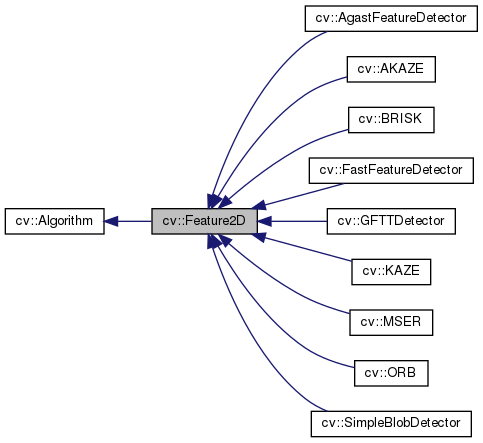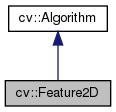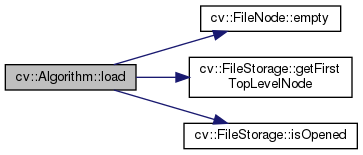Abstract base class for 2D image feature detectors and descriptor extractors. More...
#include <opencv2/features2d.hpp>


Public Member Functions | |
| virtual | ~Feature2D () |
| virtual void | clear () |
| Clears the algorithm state. More... | |
| virtual void | compute (InputArray image, std::vector< KeyPoint > &keypoints, OutputArray descriptors) |
| Computes the descriptors for a set of keypoints detected in an image (first variant) or image set (second variant). More... | |
| virtual void | compute (InputArrayOfArrays images, std::vector< std::vector< KeyPoint > > &keypoints, OutputArrayOfArrays descriptors) |
| This is an overloaded member function, provided for convenience. It differs from the above function only in what argument(s) it accepts. More... | |
| virtual int | defaultNorm () const |
| virtual int | descriptorSize () const |
| virtual int | descriptorType () const |
| virtual void | detect (InputArray image, std::vector< KeyPoint > &keypoints, InputArray mask=noArray()) |
| Detects keypoints in an image (first variant) or image set (second variant). More... | |
| virtual void | detect (InputArrayOfArrays images, std::vector< std::vector< KeyPoint > > &keypoints, InputArrayOfArrays masks=noArray()) |
| This is an overloaded member function, provided for convenience. It differs from the above function only in what argument(s) it accepts. More... | |
| virtual void | detectAndCompute (InputArray image, InputArray mask, std::vector< KeyPoint > &keypoints, OutputArray descriptors, bool useProvidedKeypoints=false) |
| Detects keypoints and computes the descriptors. More... | |
| virtual bool | empty () const CV_OVERRIDE |
| Return true if detector object is empty. More... | |
| virtual String | getDefaultName () const CV_OVERRIDE |
| Returns the algorithm string identifier. More... | |
| void | read (const String &fileName) |
| virtual void | read (const FileNode &) CV_OVERRIDE |
| Reads algorithm parameters from a file storage. More... | |
| virtual void | save (const String &filename) const |
| Saves the algorithm to a file. More... | |
| void | write (const String &fileName) const |
| virtual void | write (FileStorage &) const CV_OVERRIDE |
| Stores algorithm parameters in a file storage. More... | |
| void | write (const Ptr< FileStorage > &fs, const String &name=String()) const |
Static Public Member Functions | |
| template<typename _Tp > | |
| static Ptr< _Tp > | load (const String &filename, const String &objname=String()) |
| Loads algorithm from the file. More... | |
| template<typename _Tp > | |
| static Ptr< _Tp > | loadFromString (const String &strModel, const String &objname=String()) |
| Loads algorithm from a String. More... | |
Protected Member Functions | |
| void | writeFormat (FileStorage &fs) const |
Abstract base class for 2D image feature detectors and descriptor extractors.
|
virtual |
|
inlinevirtualinherited |
Clears the algorithm state.
Reimplemented in cv::FlannBasedMatcher, and cv::DescriptorMatcher.
|
virtual |
Computes the descriptors for a set of keypoints detected in an image (first variant) or image set (second variant).
| image | Image. |
| keypoints | Input collection of keypoints. Keypoints for which a descriptor cannot be computed are removed. Sometimes new keypoints can be added, for example: SIFT duplicates keypoint with several dominant orientations (for each orientation). |
| descriptors | Computed descriptors. In the second variant of the method descriptors[i] are descriptors computed for a keypoints[i]. Row j is the keypoints (or keypoints[i]) is the descriptor for keypoint j-th keypoint. |
|
virtual |
This is an overloaded member function, provided for convenience. It differs from the above function only in what argument(s) it accepts.
| images | Image set. |
| keypoints | Input collection of keypoints. Keypoints for which a descriptor cannot be computed are removed. Sometimes new keypoints can be added, for example: SIFT duplicates keypoint with several dominant orientations (for each orientation). |
| descriptors | Computed descriptors. In the second variant of the method descriptors[i] are descriptors computed for a keypoints[i]. Row j is the keypoints (or keypoints[i]) is the descriptor for keypoint j-th keypoint. |
|
virtual |
|
virtual |
|
virtual |
|
virtual |
Detects keypoints in an image (first variant) or image set (second variant).
| image | Image. |
| keypoints | The detected keypoints. In the second variant of the method keypoints[i] is a set of keypoints detected in images[i] . |
| mask | Mask specifying where to look for keypoints (optional). It must be a 8-bit integer matrix with non-zero values in the region of interest. |
|
virtual |
This is an overloaded member function, provided for convenience. It differs from the above function only in what argument(s) it accepts.
| images | Image set. |
| keypoints | The detected keypoints. In the second variant of the method keypoints[i] is a set of keypoints detected in images[i] . |
| masks | Masks for each input image specifying where to look for keypoints (optional). masks[i] is a mask for images[i]. |
|
virtual |
Detects keypoints and computes the descriptors.
|
virtual |
Return true if detector object is empty.
Reimplemented from cv::Algorithm.
|
virtual |
Returns the algorithm string identifier.
This string is used as top level xml/yml node tag when the object is saved to a file or string.
Reimplemented from cv::Algorithm.
Reimplemented in cv::AKAZE, cv::KAZE, cv::SimpleBlobDetector, cv::GFTTDetector, cv::AgastFeatureDetector, cv::FastFeatureDetector, cv::MSER, cv::ORB, and cv::BRISK.
|
inlinestaticinherited |
Loads algorithm from the file.
| filename | Name of the file to read. |
| objname | The optional name of the node to read (if empty, the first top-level node will be used) |
This is static template method of Algorithm. It's usage is following (in the case of SVM):
In order to make this method work, the derived class must overwrite Algorithm::read(const FileNode& fn).
References CV_Assert, cv::FileNode::empty(), cv::FileStorage::getFirstTopLevelNode(), cv::FileStorage::isOpened(), and cv::FileStorage::READ.

|
inlinestaticinherited |
Loads algorithm from a String.
| strModel | The string variable containing the model you want to load. |
| objname | The optional name of the node to read (if empty, the first top-level node will be used) |
This is static template method of Algorithm. It's usage is following (in the case of SVM):
References CV_WRAP, cv::FileNode::empty(), cv::FileStorage::getFirstTopLevelNode(), cv::FileStorage::MEMORY, and cv::FileStorage::READ.

| void cv::Feature2D::read | ( | const String & | fileName | ) |
|
virtual |
Reads algorithm parameters from a file storage.
Reimplemented from cv::Algorithm.
|
virtualinherited |
Saves the algorithm to a file.
In order to make this method work, the derived class must implement Algorithm::write(FileStorage& fs).
| void cv::Feature2D::write | ( | const String & | fileName | ) | const |
|
virtual |
Stores algorithm parameters in a file storage.
Reimplemented from cv::Algorithm.
|
inline |
|
protectedinherited |